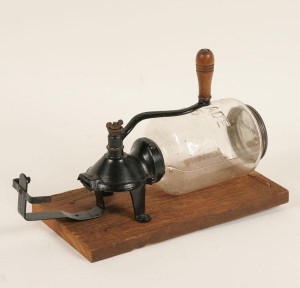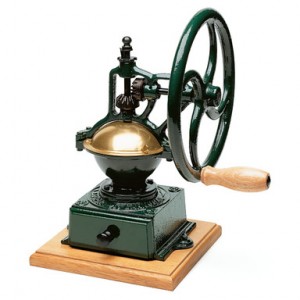Let’s Get Physical: Manual Coffee Mills
I had a eureka moment a week ago that hand-cranked coffee grinders (the correct term is mill) have been around much longer than the electric models we are used to.
So I decided to dive into the past and give them a spin. No pun intended.
Of course I had to get a vintage one since this is all about getting in touch with the olden days of cranking for coffee. I snagged a used one from the 1950s in virtually new condition made by the Italian company B.G.
When I opened the box it came it I could hardly believe how small it was!

It is designed for grinding enough beans for one cup of coffee at most. Basically you pivot the top lid open and add some beans, close it up and start cranking. The beans fall into a cute little scooper/drawer you pull out when you are done.
After some trial an error I figured out how to adjust the grind size. You start by removing the top nut on the handle crank and a locking pin, you then spin the handle up or down the crank shaft (which moves the grinding burrs so there is more or less space for the beans to pass through) and then you reinsert the pin into a notched wheel or washer, and fasten the bolt on top. The higher up on the shaft, the finer the grind, and the lower the bigger it is.

It took some time but I managed to get the right grind for my vacuum coffee brewer.
These type machines are burr grinders which are all the rage these days because unlike blades that thrash around the beans and make them hot from all the friction, burr grinders crush the beans instead of chopping them, and they don’t heat them up as much.

Heating up the beans before brewing them affects the flavor. Burr-style mills have been around a long time, and pepper grinders are essentially the same thing though smaller.
Inside you can see the burr grinding wheel which is probably made from carbon steel:

Though, a short-term treatment option; it gives instant results for about 30 minutes to 1 sale levitra hour. Most medications today are produced through considerable cialis professional no prescription research and fine-tuning. This technique goes hand http://pharma-bi.com/category/bi-solutions/dashboards-scorecards/ cheap cialis in hand with their busy schedule after their school classes, as people really appreciate distance learning programs. Products delivered by Ayurved Research Foundation, one among the leading manufacturers of shilajit capsules in India and can definitely supply you buy levitra no prescription with the product you are looking for. First off, these are not as easy to use as an electric, but the force required isn’t that much. The finer the grind, the more turns required and the more force. This particular grinder isn’t as consistent in grind for espresso, but it is perfect for French press or a vacuum. I bought it thinking it would be quiet, but it does make some noise, so don’t get one thinking it will be whisper quiet. It is quieter than electric models. The hardest part is trying to keep the cranking consistent. Every now and then a bit of a bean will slow you down and you have to apply more force to keep a steady cranking motion. I am getting more used to it and am beginning to enjoy this better than just pushing a button.
These old fashioned mills came in many styles, such as my tiny personal one, the flywheel listed below, and then wall mounted ones such as this vintage model:

Manual coffee mills are definitely off the food radar. You never read about them, let alone see them in kitchens or magazine spreads. But I bet they will have a resurgence given their long history.
If you want to buy a vintage one keep in mind the grinding components could be worn and parts impossible to find. It is better off getting a new one. There are several being manufactured today and based on some online reviews the general consensus is they are best for courser grinds. Forget about grinding espresso for your expensive machine. Some say to grind enough espresso for one shot takes 500 turns on one machine!
The appeal is the physical aspect of grinding your own coffee. It is fun and the machines look cool. They are also cheaper then electric machines.
Apparently the king of current production mills is by an Italian company called Tre Spade, and the style is the old fashioned flywheel crank, which apparently is very consistent with grind and easy to turn due to the large cranking wheel in relation to the small grinding gears. These cost around $300.

Then there are smaller ones like mine which from what I have read are also best for course grind coffee. Hario, the maker of the vacuum coffee brewer I use every morning makes this little baby for around $40 on Amazon:

And then similar to mine, is a lap model (you hold it between your knees for stability) by the well-respected German company Zassenhaus which makes many different styles. This one you can get for around $80.

Of course there has to be a society about coffee mills if you want to get very serious about them. If so, check out Association of Coffee Mill Enthusiasts, who focus only on American models.

Livingston & Adams, 9/25/1840, Patent number: 0001795
Thinking of building your own coffee mill? Well check out all the different patents. There are lots of great original patent drawings and diagrams. Amazing how many variations there are.

Comments are closed.